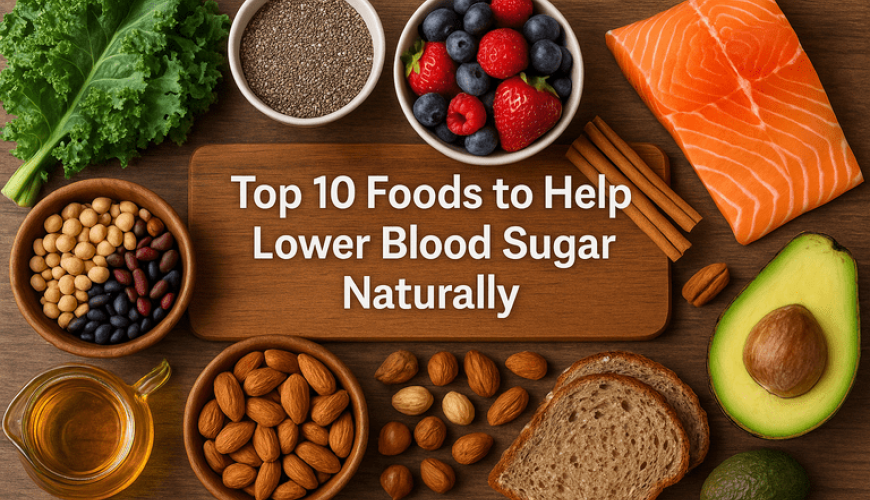
Managing blood sugar levels is critical for individuals with diabetes and those at risk. A balanced diet rich in specific foods can play a pivotal role in naturally lowering blood sugar levels and improving overall metabolic health. Here are the top 10 foods that can significantly help stabilize glucose levels and support better insulin sensitivity.
1. Leafy Greens: Nutrient-Dense and Low in Carbohydrates
Spinach, kale, collard greens, and other leafy vegetables are packed with vitamins A, C, and K, magnesium, and antioxidants, while being extremely low in digestible carbohydrates. Their high fiber content slows down the absorption of sugar in the bloodstream, helping to prevent spikes in blood glucose levels.
Magnesium, in particular, has been shown to improve insulin sensitivity, making leafy greens a daily must-have for those managing diabetes.
2. Chia Seeds: Fiber Powerhouse for Blood Sugar Control
Chia seeds are rich in soluble fiber, which absorbs water and forms a gel-like consistency in the stomach, slowing digestion and the release of sugar into the bloodstream. Just one ounce of chia seeds contains 10 grams of fiber, most of which is soluble.
They also offer a plant-based source of omega-3 fatty acids, which help reduce inflammation — a contributing factor to insulin resistance.
3. Berries: Antioxidant-Rich and Low-Glycemic Fruits
Blueberries, strawberries, raspberries, and blackberries are not only delicious but also incredibly beneficial for blood sugar regulation. These fruits are high in polyphenols and anthocyanins, which improve insulin sensitivity and reduce oxidative stress.
Despite their natural sweetness, berries have a low glycemic index (GI) and are less likely to cause blood sugar spikes compared to other fruits.
4. Fatty Fish: Protein-Rich and Anti-Inflammatory
Salmon, mackerel, sardines, and trout are excellent sources of high-quality protein and omega-3 fatty acids (EPA and DHA), which have powerful anti-inflammatory effects. Chronic inflammation is linked to insulin resistance and elevated blood sugar levels.
Eating fatty fish at least twice a week supports heart health, reduces inflammation, and helps regulate glucose metabolism.
5. Cinnamon: A Potent Spice for Blood Sugar Regulation
Cinnamon contains bioactive compounds that mimic insulin and enhance glucose uptake by cells. Numerous studies have shown that consuming cinnamon can lead to lower fasting blood sugar and improved hemoglobin A1c levels.
Ceylon cinnamon is preferred over Cassia for long-term use due to its lower coumarin content. Adding ½ to 1 teaspoon daily to your meals can support better glycemic control.
6. Legumes: Complex Carbohydrates with High Fiber
Lentils, chickpeas, black beans, and kidney beans are rich in complex carbohydrates, protein, and soluble fiber. These nutrients slow down digestion and glucose absorption, preventing sharp rises in blood sugar after meals.
Legumes also have a low glycemic load and are associated with improved insulin sensitivity and better glycemic control over time.
7. Nuts: Healthy Fats and Blood Sugar Balance
Almonds, walnuts, pistachios, and cashews are excellent snacks for those monitoring their blood sugar. Nuts provide a good mix of monounsaturated fats, fiber, and protein, all of which help slow down glucose absorption.
Studies have shown that regular nut consumption is linked to lower fasting blood sugar and reduced inflammation, both of which support long-term diabetes management.
8. Apple Cider Vinegar: Enhancing Insulin Sensitivity
Apple cider vinegar has been studied for its role in improving insulin function and lowering post-meal blood sugar levels. Acetic acid in vinegar slows down the conversion of carbohydrates into sugar and reduces glycemic response after meals.
Consuming 1–2 tablespoons diluted in water before meals can offer noticeable improvements in blood sugar control. However, it should be used cautiously and never consumed undiluted.
9. Whole Grains: Fiber-Rich and Low Glycemic Options
Quinoa, oats, brown rice, and barley are superior to refined grains due to their high fiber and nutrient content. Whole grains reduce insulin spikes and promote satiety, which helps control appetite and blood sugar.
In particular, steel-cut oats and hulled barley have shown significant benefits in lowering postprandial glucose levels compared to their processed counterparts.
10. Avocados: Rich in Healthy Fats and Low in Sugar
Avocados are low in carbohydrates and contain healthy monounsaturated fats, which support stable blood sugar levels and enhance insulin sensitivity. They're also packed with fiber, potassium, and antioxidants, making them a superior choice for blood sugar regulation.
Replacing high-carb foods with avocados can reduce overall calorie intake and improve metabolic markers.
Bonus Tips for Blood Sugar Management
In addition to incorporating these top 10 foods, consider the following practices to enhance your blood sugar control:
Stay Hydrated: Drinking water helps the kidneys flush out excess glucose through urine.
Exercise Regularly: Physical activity increases insulin sensitivity and allows muscles to use glucose efficiently.
Prioritize Sleep: Poor sleep disrupts hormone balance and increases insulin resistance.
Monitor Portion Sizes: Even healthy foods can cause spikes if consumed in excess.
Avoid Sugary Beverages and Refined Carbs: These cause rapid glucose spikes and contribute to insulin resistance.
Conclusion
Incorporating these nutrient-dense foods into your daily diet can dramatically improve your blood sugar regulation and support overall health. Focus on whole, minimally processed options that provide high fiber, healthy fats, and a low glycemic impact.
Small, consistent dietary changes can lead to substantial improvements in insulin sensitivity, reduced inflammation, and better long-term blood sugar control.
Tags:blood sugardiabeteslower blood sugarnatural remediesdiabetic diethealthy eatinginsulin sensitivitylow glycemic foodsdiabetes managementnutritionsuperfoodsglucose controldiabetic-friendly foodsbalanced diethealthy lifestyle
















Write a comment